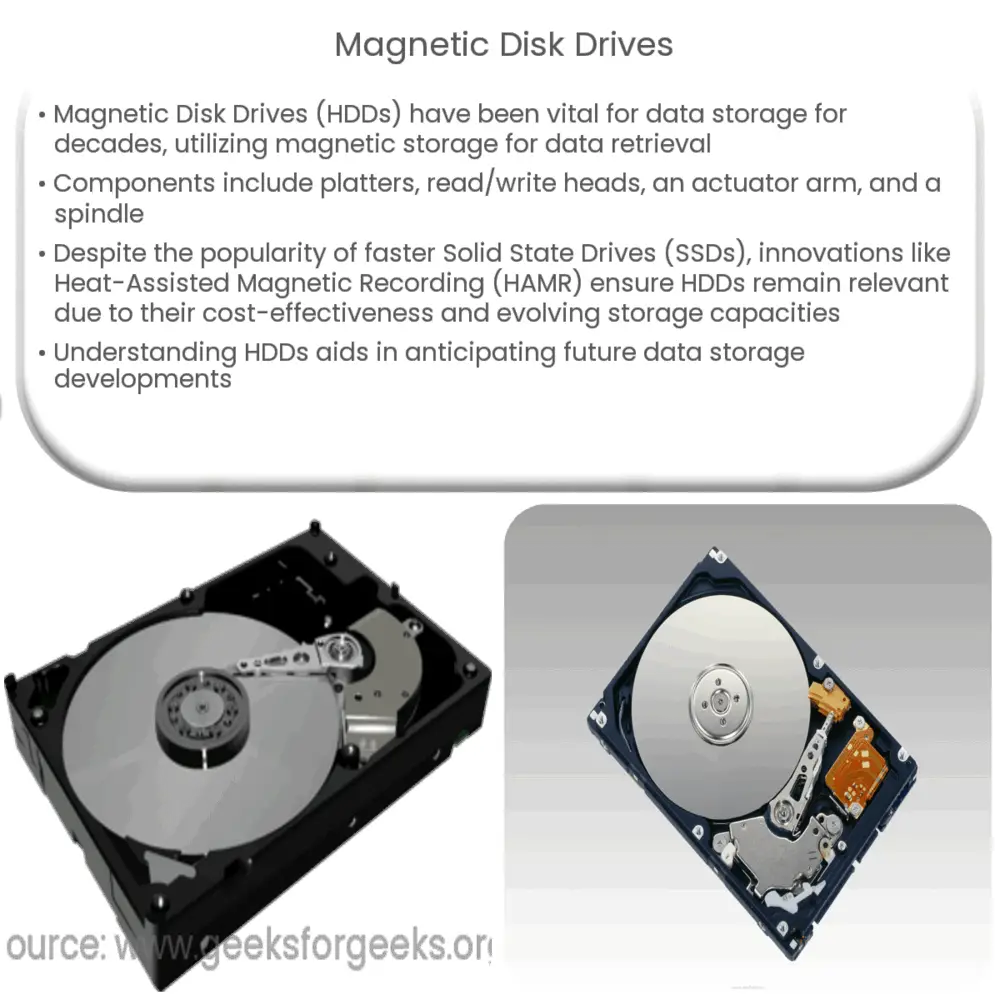Explore the history, workings, and future of Magnetic Disk Drives, a crucial component of data storage technology.

Introduction to Magnetic Disk Drives
Magnetic Disk Drives have been the cornerstone of data storage for several decades. From the early days of large, cumbersome drives, to the sleek, high-capacity models of today, they have provided a reliable and efficient method for storing and retrieving data.
What is a Magnetic Disk Drive?
A Magnetic Disk Drive, often shortened to hard drive or HDD (Hard Disk Drive), is a type of non-volatile storage device. It stores and retrieves digital information using magnetic storage. This is achieved by rotating platters coated with magnetic material. The data is written and read by a ‘head’ that moves across the surface of the platters as they spin.
The Components of a Magnetic Disk Drive
- Platters: These are the ‘disks’ in a disk drive. They are typically made of aluminum or glass and are coated with a thin layer of magnetic material.
- Read/Write Heads: These are the devices that interpret or modify the magnetic field on the platters. When writing data, the heads produce a magnetic field that changes the orientation of the magnetic particles on the platters.
- Actuator Arm: This is the component that moves the read/write heads across the surface of the platters.
- Spindle: This is the axis that the platters spin around. The speed of the spin, measured in RPM (Revolutions Per Minute), is a significant factor in the performance of the drive.
The Working Principle of Magnetic Disk Drives
The core of a magnetic disk drive’s operation lies in the properties of magnetism. A hard disk drive uses magnetism to store data, with each bit of data represented by the polarity of a magnetic domain. The read/write heads generate a magnetic field that aligns these domains to represent either a 0 or a 1 – the binary system that is the foundation of digital data.
Types of Magnetic Disk Drives
- Hard Disk Drives (HDD): These are the most common type of magnetic disk drives. They offer high storage capacities and are relatively inexpensive, making them ideal for many uses, from personal computers to enterprise servers.
- Floppy Disk Drives: These are an older form of magnetic disk drive. They have significantly less storage capacity than HDDs and are mostly obsolete today.
Performance of Magnetic Disk Drives
The performance of a magnetic disk drive is largely dictated by its RPM and data density. The higher the RPM, the faster the drive can access and transfer data. Moreover, higher data density – the number of bits that can be stored in a given area – also enhances the drive’s performance. However, despite their significant capacities and relatively low cost, HDDs have certain limitations, primarily in terms of speed and susceptibility to physical damage, which has led to the rise of Solid State Drives (SSDs).
The Advent of Solid State Drives (SSDs)
In recent years, the Solid State Drive, which uses flash memory instead of magnetic storage, has become increasingly popular. SSDs offer several advantages over traditional HDDs, such as faster data access and transfer speeds, lower power consumption, and greater durability. However, as of my knowledge cutoff in September 2021, SSDs were still more expensive per gigabyte than HDDs, making magnetic disk drives still relevant for many users who require large storage capacities at an affordable cost.
The Future of Magnetic Disk Drives
Despite the rise of SSDs, the future of magnetic disk drives is not bleak. Innovations such as Heat-Assisted Magnetic Recording (HAMR) and Microwave-Assisted Magnetic Recording (MAMR) are expected to significantly increase the data density of HDDs, making them more competitive in terms of storage capacity. Additionally, their cost-effectiveness continues to make them a viable choice for many businesses and individuals.
Conclusion
In conclusion, magnetic disk drives have been an integral part of the technological landscape for decades, serving as a reliable and cost-effective means of data storage. Despite the emergence of newer technologies like SSDs, innovations in magnetic storage continue to secure the relevance of these drives in the future. Understanding the mechanics and the principles behind these drives not only helps us appreciate the intricacies of our current digital age but also lets us anticipate and adapt to the changes that the future of data storage might bring.



